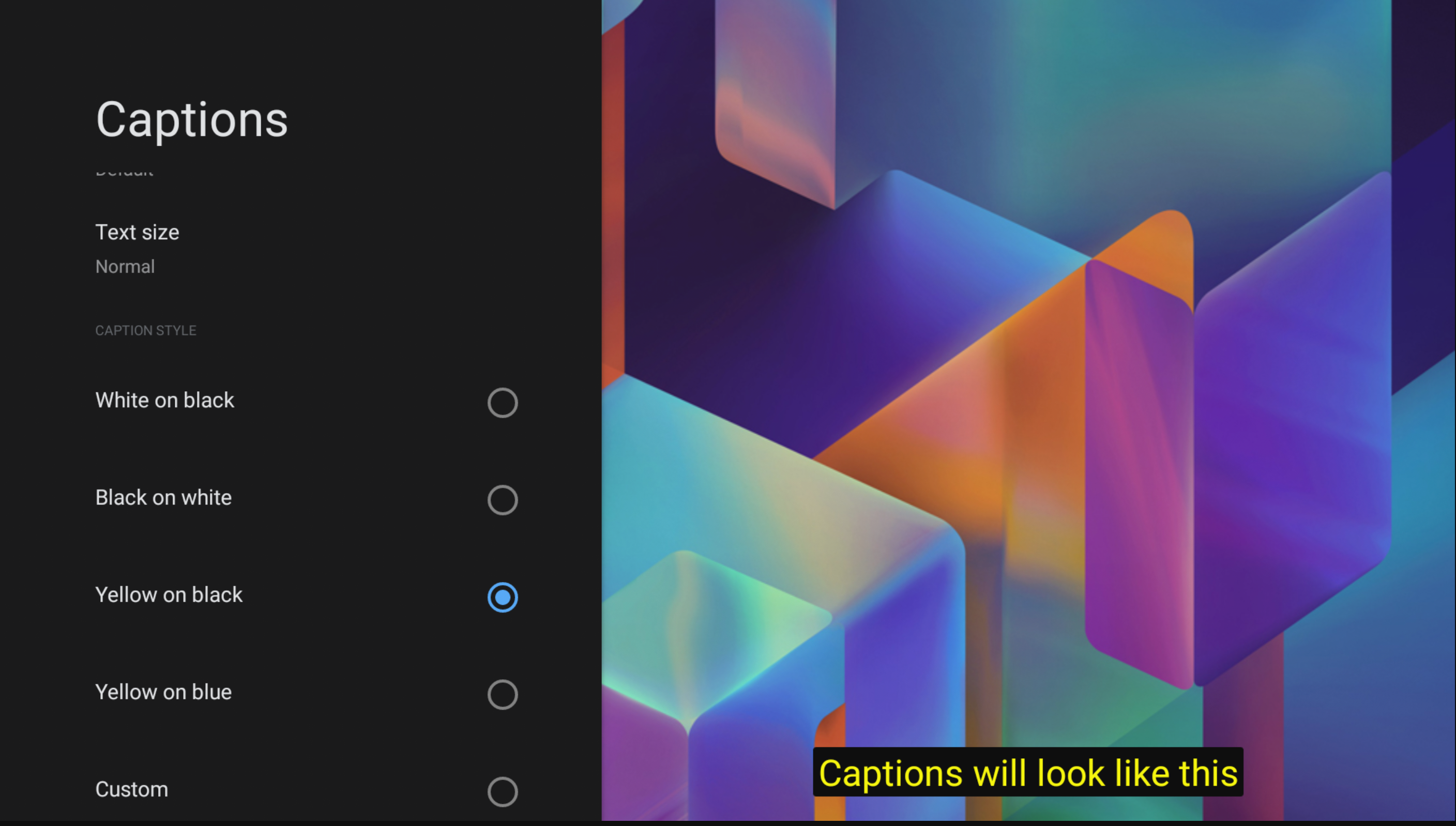অ্যান্ড্রয়েড টিভিতে, ব্যবহারকারীদের নিজস্ব ক্যাপশন শৈলী সংজ্ঞায়িত করার জন্য সেটিংস প্রদান করা হয়। এই নির্দেশিকাটি প্রদর্শন করে যে কীভাবে একটি অ্যাপ সিস্টেম-প্রদত্ত ক্যাপশন শৈলী পেতে এবং প্রয়োগ করতে পারে।
ক্যাপশন বিকল্পগুলি সেটিংস > সিস্টেম > অ্যাক্সেসিবিলিটি > ক্যাপশনের অধীনে পাওয়া যাবে:

ক্যাপশনিং ম্যানেজার পান
একটি কার্যকলাপ থেকে, আপনি CaptioningManager ব্যবহার করে এর Context থেকে ক্যাপশন পরিষেবা পেতে পারেন:
CaptioningManager captioningManager = (CaptioningManager)context.getSystemService(Context.CAPTIONING_SERVICE);
ক্যাপশন শৈলী পরিবর্তন হ্যান্ডেল
তারপরে আপনি CaptioningChangeListener প্রয়োগ করে ক্যাপশন শৈলী পরিবর্তনগুলি পরিচালনা করতে পারেন:
if (captioningManager != null) {
// Define a class to store the CaptionStyle details.
CurrentCaptionStyle currentCaptionStyle = new CurrentCaptionStyle;
// Define the listeners.
captioningManager.addCaptioningChangeListener(new CaptioningChangeListener() {
@Override
public void onEnabledChanged(boolean enabled) {
super.onEnabledChanged(enabled);
Log.d(TAG, "onEnabledChanged");
currentCaptionStyle.isEnabled = enabled;
}
@Override
public void onLocaleChanged(@Nullable Locale locale) {
super.onLocaleChanged(locale);
Log.d(TAG, "onLocaleChanged");
currentCaptionStyle.locale = locale;
}
@Override
public void onFontScaleChanged(float fontScale) {
super.onFontScaleChanged(fontScale);
Log.d(TAG, "onFontScaleChanged");
currentCaptionStyle.fontScale = fontScale;
}
@Override
public void onUserStyleChanged(@NonNull CaptionStyle userStyle) {
super.onUserStyleChanged(userStyle);
Log.d(TAG, "onUserStyleChanged");
currentCaptionStyle.hasBackgroundColor = userStyle.hasBackgroundColor();
currentCaptionStyle.backgroundColor = userStyle.backgroundColor;
currentCaptionStyle.backgroundOpcity = userStyle.backgroundColor >>> 24;
currentCaptionStyle.hasForegroundColor = userStyle.hasForegroundColor();
currentCaptionStyle.foregroundColor = userStyle.foregroundColor;
currentCaptionStyle.foregroundOpacity = userStyle.foregroundColor >>> 24;
currentCaptionStyle.hasWindowColor = userStyle.hasWindowColor();
currentCaptionStyle.windowColor = userStyle.windowColor;
currentCaptionStyle.windowOpcity = userStyle.windowColor >>> 24;
currentCaptionStyle.hasEdgeColor = userStyle.hasEdgeColor();
currentCaptionStyle.edgeColor = userStyle.edgeColor;
currentCaptionStyle.hasEdgeType = userStyle.hasEdgeType();
currentCaptionStyle.edgeType = userStyle.edgeType;
currentCaptionStyle.typeFace = userStyle.getTypeface();
}
});
CaptionStyle সিস্টেম পেতে, আপনি getUserStyle() সরাসরি কল করতে পারেন:
CaptionStyle systemCaptionStyle = captioningManager.getUserStyle();

